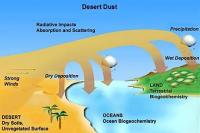- Use environmental data and themes to help your students apply mathematics to real-world problems. Assign environmentally-themed math problems, analyze data such as population figures, land use statistics, and pollutant levels, use data to draw inferences about changes in population and natural resource consumption, and have students explain the impacts of their analysis. Use the search function to the right to explore other ways to use environmental data in your classroom.
- StoryPosted bycgray3onFebruary 1, 2011
The amount of dust in the Earth's atmosphere has doubled over the last century, according to a new study; and the dramatic increase is influencing climate and ecology around the world.
Posted in: - ResourcePosted byAnonymousonMarch 24, 2010
In this lesson, students discover water and energy connections by learning how sources of energy require substantial amounts of water and how energy is used in the process of providing tap water to millions of homes.
Posted in:
Latest in this Subject
View more News, Resources , Professional Development, Grants, Success Stories
- ResourcePosted bymedudaonJune 29, 2011
This activity, developed by Smithsonian Education and tied to National Science Content Standards and National Mathematics Standards, helps introduce environmental issues using fun and challenging real-world math problems. Students do the work of a team of paleontologists studying a time of rapid global warming 55 million years ago.
- ResourcePosted bycaitlineonJune 24, 2011
In this Project Wild activity from the Council for Environmental Education, students identify ways that oil spills can adversely affect birds and explore the negative impacts pollutants can have on wildlife, people and the environment. The lesson is appropriate for grades 5-8 and aligns with national science and mathematics standards.
- ResourcePosted bycaitlineonJune 24, 2011
This set of activities from the Gulf of Maine Aquarium helps students conceptualize the effects of an oil spill on local wildlife, the enormity of the amount of oil used every day and the size of an oil tanker. The activities are most appropriate for middle school students and can be adapted to meet educational standards in science, math and social studies.
- ResourcePosted bycaitlineonJune 24, 2011
Goo-Be-Gone is a science fair project idea from Science Buddies that tests the absorptivity of different materials to determine which are the best for cleaning up oil spills. The project is most appropriate for middle and high school students and can be adapted to meet educational standards in science and math.
View resource - ResourcePosted bycaitlineonJune 24, 2011
Written in 1990 after the Exxon Valdez oil spill and updated in 2007, this curriculum provides materials for grades K-3, 4-6 and 7-12, as well as a list of several articles, books and other educational resources. The materials were developed by the Prince William Sound Science Center, the Prince William Sound Regional Citizen's Advisory Council and the Prince William Sound Community College.
View resource
Do you know of a resource that you think other teachers should know about?
Share your resource!



